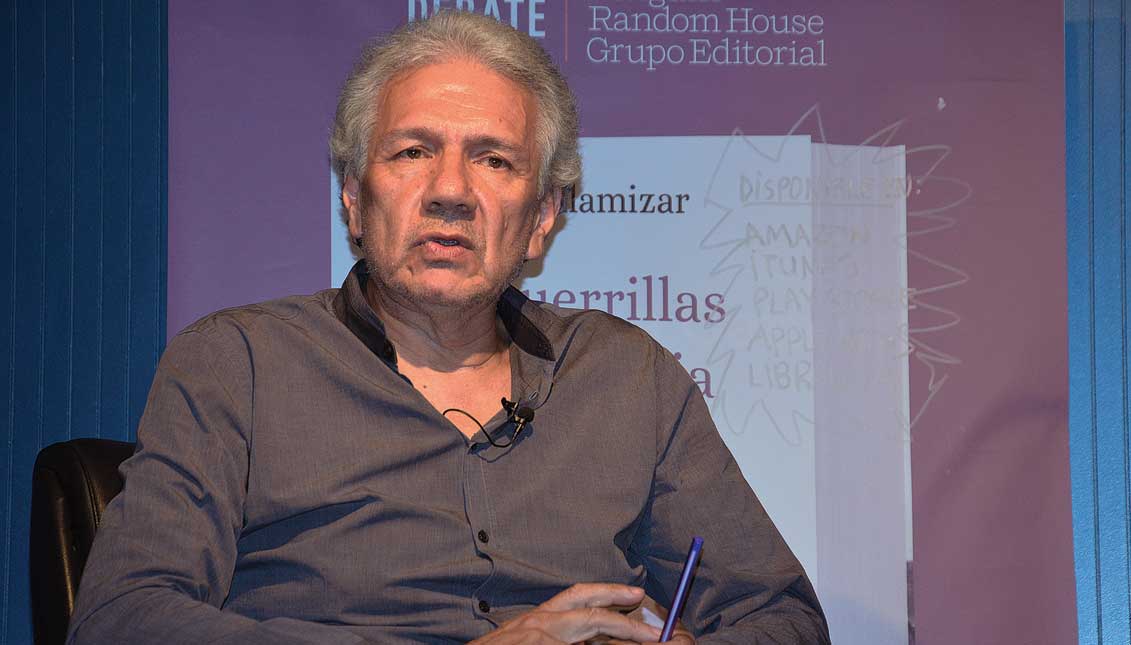
"If something is flourishing now in Colombia are the memories"
Colombian political scientist Darío Villamizar presents his book "The guerrillas in Colombia" where he tells and analyzes the almost 70 years of this…
Everyone has heard at least once of the FARC, Escobar, the guerrillas and the peace agreement promoted by the country's current president, Juan Manuel Santos, winner of the Nobel Peace Prize last year.
Nonetheless, for non-Colombians, guerrillas remain a complex and distant problem. Where do they come from? Why do they fight? Are they moving in the interests of drug cartels or defending any political cause?
In his new book, "The Guerrillas in Colombia" (Debate, 2017) Colombian political scientist and writer Darío Villamizar makes a complete review of the emergence, development and final process of guerrilla organizations in Colombia between 1950 and today, based on an exhaustive documentation effort that led him to spend long seasons in the USA.
"I spent a lot of time researching documents declassified by the US government and found things very curious," Villamizar explained at a conference at Casa América Barcelona (Spain) at the end of September.
Among the curious things investigated by Villamizar, an adviser on reincorporation of ex-combatants at the UN and a member of the Latin America Studies Association (LASA), for example, is the death of Camilo Torres, a member of the guerrilla group Army of National Liberation (ELN) . In his book he recounts the life of Torres, who was assassinated by the army in 1966 and is still unknown where he was buried. In January 2016 President Santos instructed the ELN to begin the search and exhumation of his remains, in a gesture to accelerate the beginning of the peace talks with the guerrilla group.
Villamizar collaborated with prestigious American journalist Jon Lee Anderson, an expert on social movements in Latin America and author of El Che, a revolutionary life, the best biography of Che written until today, according to Villamizar. Villamizar explains that his intention is not only to carry out a detailed account of more than thirty different guerrilla groups but also to link the guerrillas with other movements and social contexts in Latin America and in the rest of the world since the Cold War (where they cooked) to the influence of Cuba or the United States.
"I've always wanted to tell the facts for those who didn’t have the opportunity to meet them," explains Villamizar before an audience that has come to listen to him, mostly Latin American students in Barcelona.
According to the author, after more than 30 years of peace negotiations, "if something is now flourishing in Colombia are memories," he adds. And it highlights two recently published books on this subject: the novel "No hay fiesta", written by the former mayor of Medellín, Alonso Salazar, where the author recounts the stories of his friends of the University of Antioquia and tells the life of militants of guerrillas, in an era marked by the paramilitaries and the FARC. Or the “(Private) History of Violence," which chronicles the mid-20th century Colombian crisis based on interviews with the descendants of its protagonists. "It gives a vision of the country through what their parents told in family meals," Villamizar explains referring to Patiño's book.
To differentiate itself from other books on guerrillas published to date, Villamizar says he "tried to pick up a more complete version," from the origin of the guerrillas to the culmination of the peace process in November last year.
After analyzing more than 420 guerrilla groups across the continent, why was Colombia the last country to end the guerrillas? Villamizar was asked in a recent interview with the Spanish newspaper ABC.
There are certain factors, one of them is geographical, replied the author. "Colombia is a complex country of regions, mountains, jungle, with two coasts, with a very easy entry to the north of the continent by Panama. A group in the jungle is undetectable," he said.
RELATED CONTENT
On the other hand, Villamizar insists on highlighting in the economic forms they used to subsist, all of them illegal: "Blackmail, kidnapping, illegal mining, wildlife and drug trafficking... Illegal economies that generated income access to the guerrilla in different dimensions. They did not necessarily constitute the great cocaine cartel, but certain gangs in that chain could be or participated in some armed groups," he told ABC.
Now, almost a year after the signing of the peace treaty, "one of the things that worries me the most about Colombia is compliance with the agreement," Villamizar confessed in Barcelona.
First, because President Santos has a fairly strong opposition within Congress, he has opposition from parties and voters who are constantly criticizing him, he told the ABC newspaper.
But, according to the renowned political scientist, the two points that will generate the most difficulties when implementing the peace agreement after the disarmament process is completed are, firstly, the transition from the guerrilla to political force, and secondly, the social reintegration of the guerrillas.
"We must locate the FARC as a political party, not just as a cartel," he insisted. "That their political proposal is attractive afterwards is their thing, but at least they have the tools". This challenge will be especially complex for the ELN, as it has a "very particular cultural identity, they work in consensus, through consultation ... any vertical party decision structure will break them."
The second challenge to get guerrillas back into civilian life is even more complicated.
"The ex-combatant must be clear that he can integrate into society and have money to feed his families, otherwise he will return to arms," he said.
And that is very difficult, because the Colombian society - the community - is not prepared to guarantee this reintegration. "They are going to meet a polarized country, where the ordinary citizen rejects them," he said. And excluding ex-combatants would be a serious mistake. "Ideally, we should welcome them in the best way possible and allow them to express themselves," he concluded.











LEAVE A COMMENT: